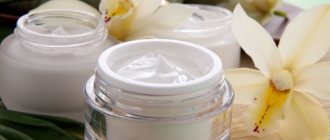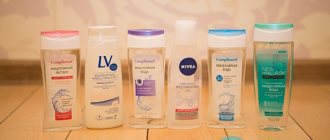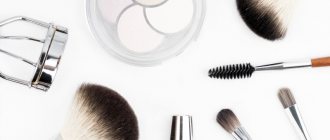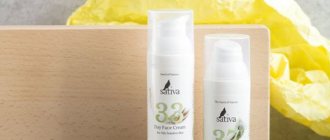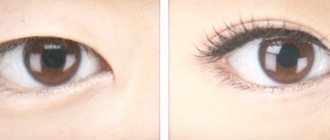When buying another cosmetic product, we sometimes don’t even think about what exactly its ingredients are and how they affect our skin.
However, any cosmetic product is a complex set of components based on modern developments and knowledge accumulated over centuries. And behind the complex names in the composition of a cosmetic product there is a whole world of components that have different effects on the skin.
In fact, what works for some people may not necessarily work for others. And sometimes even natural ingredients can cause an allergic reaction in sensitive people.
The list below will allow you to find out what the names of the components mean and what role they play in the composition of cosmetics.
Agar-agar , obtained from White Sea and Far Eastern algae, is used as an emulsifier in low-fat creams.
Arachidonic acid is added to creams as a nutritional supplement.
Silk proteins , or sericin, prevent moisture loss by forming a protective film on the surface of the skin.
Benzyl alcohol is a powerful disinfectant. In decorative cosmetics it is used as a preservative.
Benzoic acid , like benzoic oil, is used as a preservative and has an anti-inflammatory effect on the skin.
Butylene glycol helps retain moisture in the skin, and also enhances the effect of other components in the cosmetic product.
Valine is an amino acid that retains moisture in skin cells.
Hyposulfite , which contains sulfur, can be used in cosmetology to treat skin diseases.
Glycerin is an alcohol that can retain moisture in the skin. It also acts as an antiseptic, preventing the development of pathogenic bacteria not only on the skin, but also in the jar of cream itself, acting as a natural preservative.
Titanium dioxide and zinc oxide protect the skin from harmful ultraviolet rays. They have anti-inflammatory properties and do not penetrate the skin.
Disodium in the cream softens the effect of tap water, neutralizing magnesium and calcium compounds.
Gelatin . This premium grade of natural animal glue is used as a thickener in creams. However, it is not resistant to temperature changes.
Emu oil is close in composition to the lipids of the stratum corneum of our skin and is part of expensive cosmetics. Also has good antibacterial properties.
Carageenan is an emulsifier obtained from Irish moss.
Camphor alcohol is produced from the wood of the camphor tree. It significantly tightens pores and has an effective antimicrobial effect.
Kitalan is a waxy product that, like stearyl stearate (stearol), is used in cosmetics instead of spermaceti.
Coenzyme Q 10 – moisturizes, improves skin elasticity and reduces wrinkles.
Kryolan is lanolin in liquid form.
Lanolin . This wax is obtained from sheep's wool. It is used in cosmetics as a powerful moisturizing component. Lanolin is well absorbed without leaving a greasy sheen, and also enhances metabolic processes and improves blood circulation. Despite its obvious benefits for the skin, lanolin can cause an allergic reaction.
Lecithin is a substance close to skin lipids that can “fill in” damaged areas, restoring skin cover.
Citric acid is known for its skin whitening effect and is also used to remove age spots and freckles.
Methylcellulose is used as an emulsifier.
Mineral oils (also labeled as mineral oil) are waxy vaseline, paraffin and ozokerite, substances that are obtained during the distillation of oil. In inexpensive creams they are used as thickeners. They interfere with the penetration of oxygen and are not absorbed by the skin. Acceptable in protective winter creams, some massage oils and masks.
Lactic acid , which “lives” in bread and dairy products, is used in cosmetology to moisturize and whiten the skin.
Glycerol monostearate and monoglycerides can often be found in creams, which are used as emulsifiers.
Urea is a safe and effective moisturizing substance that does not cause allergic reactions.
Mink oil is a very valuable element in cosmetics. It is absorbed very well by the skin and does not leave a greasy film on it.
Zinc oxide is used for its anti-inflammatory and antimicrobial properties.
Pentol , oleate and sorbitan oleate are emulsifiers based on oleic acid.
Propylene glycol . Currently, controversy surrounding this solvent continues. Supporters believe that it retains moisture in the skin, delivering beneficial substances to cells. Opponents argue that propylene glycol, on the contrary, helps displace fluid from the skin. However, propylene glycol is currently an officially approved food additive with classification E 1520, which is actively used in baking confectionery products.
Beeswax is a natural thickener that locks moisture into the skin. In people prone to allergic reactions, it may provoke an allergic reaction. Beeswax is a natural source of vitamins E and A, fatty acids, softens the skin and prevents inflammation.
Salicylic acid disinfects and whitens the skin, and acts as a natural preservative in cosmetic jars.
Salicylic alcohol is extracted from willow bark. Used to disinfect and whiten skin, as well as to treat acne.
Squalene , extracted from the liver oil of deep sea sharks, is able to penetrate into the deep layers of our skin, moisturizing and healing it.
Magnesium salts are active antioxidants that help the skin maintain youthfulness longer, slow down the aging process and prevent allergic reactions.
Sodium salts help nutrients penetrate deeper into skin cells.
Sorbitol is a solid alcohol that is obtained from the fruits of plums, rowan berries and cherries. In cosmetics it replaces glucose.
Spermaceti is produced from shark or whale oil and moisturizes and softens the skin. Spermaceti is close in composition to the lipids of our skin. But, like many other active natural chemicals, it is a potential allergen for people prone to allergic reactions.
Stearate is an ester of stearic acid that is used as a humectant and emulsifier.
Terlan , unlike cryolan, is solid lanolin.
Tocopherol acetate has good antioxidant properties, stimulates immune processes in the skin, improves blood circulation, increasing the lifespan of cells.
Tragacanth is a resinous substance that oozes from cracks and cuts in certain shrubs. Unique in its ability to expand twelve times when it swells. In low-fat creams and is used as an emulsifier.
Transcutol is a substance that carries active substances into cells.
Caprylic acid triglyceride is used as a base in creams. This is a type of fatty synthetic oil that is identical to natural sebum.
Ceresin is a petroleum product. In cosmetics it can be used as a structure-forming substance.
Cetyl alcohol in cosmetics acts as an emulsifier, evenly mixing the fat and water parts. It does not irritate the skin and promotes the penetration of the active substances contained in the cream.
Cyclomethicone, dimethicone and simethicone are silicone oils used in creams as emulsifiers and lubricants. A protective elastic film is formed on the skin, which does not prevent the skin from breathing, while simultaneously creating the effect of satin skin.
Acetic acid is used as a disinfectant.
Phytolen is a very gentle oil that does not cause allergies. Used as a moisturizer and bactericide.
Chitosan , obtained from crustacean shells, is used as a moisturizing gel-like moisturizing substance.
Sodium chloride is used as an antiseptic .
Of course, this is not a complete list of substances that can be included in cosmetics. Here are the most common ingredients to help you learn more about what the cosmetic product you buy will actually do.
Don’t forget the basic rule: the likelihood that a purchased tonic or cream will contain a low-quality or prohibited component is less likely in expensive products. Indeed, in real cosmetics, natural oils are added as preservatives, so if you really want to benefit your skin, you should not skimp on care and cosmetic products.
A common occurrence is that a manicurist recommends products to clients to care for the skin of their hands or feet, but with each new visit the situation only gets worse - the skin dries out even more. The reason for this is the ineffective composition.
Products for the body, hands, feet and hair may consist of:
- Basics;
- Surfactants or surfactants;
- Active components;
- Preservatives;
- Antioxidants;
- Alcohols;
- Alkalis;
- Acid.
Each substance in this case has its own role and only the correct concentration and combination can make the product effective and safe.
What ingredients should you be wary of?
There is an opinion that some oils can clog pores.
Yes, this is true, but if they are used in small quantities, they do not have any bad effect on the skin. This rule also applies to other components of cosmetic products, not just vegetable oils. When producing face creams, the main thing is to choose the right ingredients, as well as their quantity. Everything must be used in the correct dosage, which is what companies producing cosmetic products do. Even a seemingly harmless antioxidant, coenzyme, in large quantities can have a detrimental effect on the condition of the skin. In most facial products, glycerin ranks second in the list of ingredients used. It really protects and moisturizes the skin, but in dry air it changes the direction of its action and begins to make the skin even drier.
- Mineral oil
is a common ingredient in skin care products made from petroleum. The product is a mixture of liquid hydrocarbons separated from gasoline. In cosmetics it is used to create a kind of film that would not allow moisture to be retained. Keep in mind that technical oil retains not only water, but also other substances, including waste products that must be removed through the skin. At the same time, mineral oil prevents the penetration of oxygen, which is so necessary for the skin. Technical oils include petrolatum, paraffin oil and paraffin, which can cause acne and rashes. - Parahydroxybenzoate
, that is, parabens, can be found in a wide variety of cosmetics. Typically, creams without these preservatives are more expensive, and the shelf life of such products is shorter. Parabens prevent the reproduction and growth of microorganisms, but, at the same time, can lead to the occurrence of malignant formations. - Try not to use products containing formaldehyde
, which can have a detrimental effect on the skin, causing acne and allergies.
Such preservatives are at the end of the list of ingredients. Avoid 2-bromo-2-nitropropane-1,3-diol
,
5-bromo-5-nitro-1,3-dioxane
,
Diazolidinyl urea
,
Quaternium-15
,
DMDM Hydantoin
,
Imidazolidinyl urea
,
Sodium hydroxymethylglycinate
, these are commonly listed in formulations cheap products.
LiveInternetLiveInternet
O_Mila
all posts by the author
"The Safe Shopper's Bible"
According to this book, 884 toxic substances are found on the list of chemicals used in the cosmetics industry.
Here is a short excerpt from this book: “Even in the 90s, the safety of cosmetics in America is not ideal. The FFDCA does not require safety testing before cosmetics are released onto store shelves. Therefore, the FDA sometimes requires inspection only after cosmetics hit the shelves. Because of this minimal control, dangerous products may already be sold, which may harm your health, or “dumped” onto the market in developing countries at bargain prices...” Think about these words, and it will become clear to you why our markets are flooded with “real” and “famous” American, French or Swedish, completely synthetic cosmetics, which no one may have even heard of in these countries. There is nothing surprising about this. Indeed, from the very beginning of the last century, when petrochemicals and petroleum synthesis products appeared, the entire cosmetic industry has been focused only on them. And note, nothing prevents us from using the term “natural,” so beloved by women and manufacturers of cheap cosmetics. Oil is also a natural product.
Currently, cosmetic products include a variety of ingredients - biologically active substances, dyes, extracts, emulsifiers, fatty components, fragrances.
Previously, many of these components were natural (plant or animal origin), but thanks to “progress” in chemistry, now almost all components are of chemical origin. When coming to the store for “good” cosmetics, which of you was last interested in the composition of creams? We are often offered creams, shampoos, and balms containing extracts of chamomile, aloe, calendula and other beneficial substances, assuring us that these are “natural cosmetics.” But let’s try to look at the list of components ourselves, even if we have to arm ourselves with a magnifying glass. In the first rows (which means that in this cosmetic product the share of these ingredients is from 10 to 20%) we can see. • Sodium Lauryl Sulfate (SLS, Laurel, sodium sulfate, lauryl sulfate) • Sodium Laureth Sulfate (SLES, Luret, sodium sulfate, lauryl sulfate)
You will never see advertisements for these substances, because entire volumes of specialized literature have been written about their toxic effects.
This is perhaps the most dangerous of the 884 skin and hair care ingredients. Many cosmetic companies often disguise products that contain SLS (SLES) as natural ones, indicating on the labels in large letters in the most visible place - “DERIVED FROM COCONUTS” And indeed, this inexpensive ingredient is obtained from coconuts. But it should be taken into account that not everything natural is safe for humans. And yet, it is widely and widely used in the manufacture of cosmetic cleansers, shampoos, bath and shower gels, bath foamers, etc. And even in toothpastes. And experts consider this ingredient to be one of the most dangerous in dental, oral, hair and skin care products. SLS (SLES) is also actively used for industrial purposes, for example: for cleaning floors in garages, for degreasing engines and machines, in car wash products, because it has the ability to remove grease from the surface. However, it is a very strong corrosive agent. In research centers and clinics, SLS is used for various experiments as a skin irritability tester. Scientists inject this ingredient and cause skin irritations in animals and humans, and then test various new drugs to treat them. Medical studies have shown that SLS (SLES) are dangerous and, penetrating into the eyes, brain, heart, liver and other organs, accumulate there. It is especially dangerous for children, in whose tissues it accumulates in high concentrations. SLS has the ability to change the protein composition of children's eye cells and can cause serious illness, incl. cataract. SLS (SLES) leaves an irritating film on the hair and skin, which contributes to the weakening of the hair follicle, thinning and hair loss, and the appearance of dandruff. The hair shaft becomes dry and brittle, and the hair splits at the ends. In addition, SLS (SLES), coming into contact and reacting with other cosmetic ingredients, forms NITROSAMINES (NITRATES). They enter the bloodstream every day and gradually have a devastating effect on human health. • Propilene Glycol (propylene glycol)
A petroleum derivative - a sweet, caustic liquid. In industry, propylene glycol is used as antifreeze in water cooling systems and as brake fluid.
Widely used by cosmetic companies for the production of skin cleansers, creams, and moisturizers. Because, when applied to the skin, it binds fats, displacing liquid and components important for skin health, thereby achieving a temporary feeling of smooth skin. Glycerin is cheaper, so in cosmetics the typical composition includes 10-20% (it is usually one of the first in the list of ingredients, which indicates its high concentration). Even in low concentrations it is one of the main allergens and irritants. Petrochemical allergies are often accompanied by the formation of acne. Penetrating through the skin into the body, it behaves as a vascular and protoplasmic poison, capable of causing dystrophic changes in the kidneys and liver. • Mineral oil (mineral oil)
Technical oil, petrochemical waste.
Seals and suffocates the skin. Slows down the growth of young cells. Increases dehydration and reduces skin barrier function. It is the most common cause of acne and allergic rashes. Allergic reactions (petrochemical allergies) can lead to arthritis, migraines, epilepsy, and diabetes. Contains high concentrations of carcinogens - substances that cause cancer. • Petrolatum (Petrolat) / Paraffin.
Paraffin oil Petrochemical It has the same properties as mineral oil, but is more toxic.
By retaining fluid, it prevents the release of toxins and waste and prevents the skin from breathing. By the way, it is not fat, but moisture - a substance that is necessary for the skin - that nourishes it, maintains its elasticity and aesthetic appearance. Improper methods of moisturizing the skin are harmful and cause premature aging rather than rejuvenation. • Glycerin, Vaselin (glycerin, petroleum jelly)
Chemical compounds of fat with water, in which water separates fat into small components.
Advertised as a beneficial moisturizer. It causes dehydration of the skin, since when the air humidity is below 65-70%, they “pull” moisture from the deep layers of the skin to the surface instead of taking it from the air, which increases the drying of the deep layers of the epidermis, making dry skin even drier. • Lanoline (lanolin)
Sheep lard collected from sheep's wool.
It really softens the layer of dead cells, but suffocates the living ones. Foreign (sheep) proteins can increase skin sensitivity and cause allergic rashes. Lanolin of cosmetic varieties is itself safe, but it often reacts with carcinogenic substances, of which there are about 16, facilitating their entry into the body. Everything would be fine if it were not known that 49% of the carcinogenic pesticide DDT (Dust) is absorbed by lanolin through the skin. • Kaolin, Bentonite, Blue clay (Kaolin, bentonite).
Varieties of fine clay.
Often included in face masks. Plastering leather. It clogs pores and severely dries (dehydrates) the skin, traps carbon dioxide and toxins, suffocating the skin. Causes premature aging. • Talk (talc).
Works in the same way as fine clays.
It clogs pores and dries out the skin. Cosmetic talc is carcinogenic. It is especially dangerous in powder products applied to the face and inhaled by us. • Bronopol (formaldehyde).
All these substances are preservatives, derivatives of formaldehyde.
The names are so carefully disguised because formaldehyde is the most carcinogenic, neurotoxic, allergenic and irritating of all preservatives. May cause dermatitis. Many cosmetic companies no longer use this preservative, since formaldehyde can be very irritating to the eyes and skin. Don't rush to use it. We still have time to get everything into formaldehyde. However, producing cosmetic creams, which are an excellent breeding ground for microorganisms, without preservatives would, perhaps, be an even greater crime. Currently, many companies are developing preservative complexes consisting of 45 components, where each individual component is present in quantities significantly below the toxic dose. Therefore, you should avoid cosmetics that contain only 1-2 preservatives. • Aluminum silicate (aluminum silicate, aluminum alum).
Very highly corrosive.
Damages and dries out the skin. Harmful to internal organs. Tends to accumulate in brain cells, causing Alzheimer's disease (senile insanity). • Collagen (collagen).
Some companies insist that cosmetic collagen can improve the skin's own collagen structure.
Judge for yourself. Collagen is a protein (protein) that makes up almost 80% of the structural network of our skin. With age, it is destroyed, and the skin becomes thin and flabby. Cosmetic collagen is obtained by scraping it from the hides of cattle or the undersides of bird feet. Due to the large size of the molecules (molecular weight 3000 units), it is not able to penetrate the membranes of skin cells. In addition, it is a foreign protein that is biochemically different from human protein and cannot be used by the skin. As a result, it seals the skin and prevents normal breathing. Note: The only exception can be plant collagen, the small size of whose molecules allows it to penetrate the cell, where it is decomposed into components necessary for the construction of the skin’s own collagen. • Elastin (elastin)
The substance that makes up the structure that holds skin cells in place.
It is believed that the formation of wrinkles is a consequence of the destruction of elastin molecules. Unfortunately, most companies use elastin, which is obtained, like collagen, from the skin of cattle, and it also forms a suffocating film on the skin due to its high molecular weight. Only one type of cross-linked elastin is able to penetrate and combine with a human cell. This is a form of plant elastin that contains the “building material” for the synthesis of natural, own elastin, which is called desmosin or iso-desmosine (Desmosin and Iso-Desmosine). • Albumin (albumin).
The main ingredient in facial skin tightening formulations.
When dry, it forms a film over wrinkles, making them less visible. Tightens the skin, causing premature aging. Trick. Court cases have been initiated on this issue more than once. • Alpha Hydrox Acids (Alpha hydroxy acids)
Lactic acid and other acids.
Acts as an exfoliant, removing the top, protective layer of the skin. The skin looks young and less wrinkled, but environmental influences cause the skin to age faster. • Carbomer (Carbomer 940, carbomer).
A thickener used to form gels.
Due to its strong corrosive effect, it can damage the skin. • Diethanolamine (DEA) (DIETHANOLAMINE - DEA) • Triethanolamine (TEA) (TRIETHANOLAMINE - TEA)
Are used to suppress the growth of microorganisms, increase the shelf life of products.
May cause various allergic reactions and skin rashes. Research has shown that these substances have weak estrogenic effects and can be absorbed by the body through the skin. Widely used, despite the fact that their toxic effects are well known. Substances that balance pH in cosmetics. They cause severe irritation, and together with SIS (a combination often found in cosmetics) they form nitrates. • Lauramid Dea (Loramid Dey).
A semi-synthetic chemical used to form foam and thicken gels.
May dehydrate hair and skin, cause itching, photosensitivity and allergic reactions. • Hialuronic Acid (Hyaluronic acid).
An excellent moisturizer.
The latest in the cosmetics industry. Hyaluronic acid of plant origin (low-molecular form) is identical to human one and can be used externally. It is important that companies do not use it in a cheaper, high-molecular form (up to 15 million units). Molecules of hyaluronic acid of animal origin are much larger than the spaces between the cells of the stratum corneum, so their penetration into the living layers of the skin is completely excluded, not to mention their exit into the connective tissue of the dermis (although wrinkles and folds arise precisely in this area). It stays on the skin and acts like collagen. • Sodium Chloride (Salf NaCl, table salt).
Used to increase the viscosity of certain drugs.
May cause skin and eye irritation. In addition, salt microcrystals very harshly damage and dry out the skin. • Seaweed (Agar-agar).
Used in microbiology to inoculate bacteria.
Advertised as a nourishing and moisturizing product. By clogging the pores, it allows the skin to accumulate water, causing a temporary positive effect. Prevents the body from cleansing the body of toxins and carbon dioxide through the skin. It is an excellent breeding ground for microorganisms and bacteria. • Cacao Oil (cocoa butter).
Contains 2% of the caffeine-like substance theobromine.
Like caffeine, it is an intracellular diuretic. The moisturizing effect is associated with the removal of water from the cell into the intercellular space. In addition, theobromine is a strong stimulant that stimulates the energy processes of skin cells. Popular wisdom says that if you urge a horse, it will plow faster, but it will die sooner. The temporary positive effect of cocoa butter leads to irreversible negative effects - rapid deterioration of skin cells. • METHYL, PROPYL, BUTYL AND ETHYL PARABENS (METHYL, PROPYL, BUTYL AND ETHYL PARABENS)
Used to suppress the growth of microorganisms, increase the shelf life of products.
May cause various allergic reactions and skin rashes. Research has shown that these substances have weak estrogenic effects and can be absorbed by the body through the skin. Widely used, despite the fact that their toxic effects are well known. • DIAZOLIDINYL UREA, IMIDAZOLIDINYL UREA (DIAZOLIDINYLUREA, IMIDAZOLIDINYLUREA)
Widely used as preservatives.
The American Academy of Dermatology has found that they are a direct cause of contact dermatitis. These chemicals are known by two trade names: Germol II and Germall 115 (Germall II, Germall 115). None of the Germol chemicals contain antifungal agents, so they must be used in combination with other preservatives. Both of these chemicals release formaldehyde, which can be toxic. • STEARALKONIUM CHLORIDE
A quaternary ammonium compound used in hair conditioners and creams.
Developed industrially as a fabric softener; it is much cheaper and easier to use in hair conditioners than natural proteins and herbs that are beneficial for hair. Causes allergic reactions. Toxic. As you know, the composition of cosmetic products comes down to the following: 1. Base
- natural fats and oils (for example, cocoa butter, cod fish oils, lanolin, etc.), synthetic or semi-synthetic fats (castor oil, chitosan, gelatin, carbopol and etc.) which, acting on the skin, should maintain lipid balance, help retain moisture in the skin, and nourish it.
Fatty products remain on the surface of the skin for a long time, are absorbed with difficulty, and prevent the skin from breathing and releasing cell waste products. They protect the skin well from moisture evaporation, but are not able to compensate for its deficiency. The use of fat-based creams is considered acceptable for problematic dry skin and only as a temporary remedy. 2. Emulsifiers
– substances that promote the formation of stable emulsions.
Excessive addition of emulsifiers to cosmetic products disrupts skin functions, causing a feeling of tightness and dryness. 3. Preservatives
- necessary for long-term storage of cosmetics, as they suppress the development of various bacterial flora.
However, there is an important remark: what is poison for a bacterial cell is also poison for a human cell! The more natural ingredients a cream contains, the faster it deteriorates. This primarily applies to oils, fats and fat-like substances (a rancid odor appears). Preservatives prevent the oxidation of fats and fat-like components. Preservatives include: antioxidants (delay the oxidation of fatty compounds), pro-oxidant inactivators (slow down the oxidation process), bactericides and bacteriostatics (protect against microflora). 4. Fragrances
are substances that give cosmetics a pleasant smell.
It is the fragrances, most often cause an allergic reaction of the skin to cosmetics. For hypoallergenic cosmetics, special hypoallergenic fragrances are used, the cost of which is quite high (usually in high -quality cosmetics, natural essential oils play the role of fragrances). 5. Biologically active substances
- vitamins, infusions of medicinal herbs, enzymes, enzymes, etc.
Consider the substances whose names should be instructed by reasonable fears in the composition of cosmetics (as well as food). Some of them can cause an allergic reaction, and some can be very dangerous. 1. Carcinogenic:
Dea - Diethanolamine, chemical, which is used not only in creams, but also in cleansing cosmetics - lotions, cream, milk, foam and other cosmetics.
Dea has become widespread due to the formation of good foam and laundering. The dea component itself is not harmful, but in reaction with other components in a cosmetic formula, it is able to form an extremely powerful carcinogenic substance called Nitrosodiethanolamine (NDEA). NDEA is easily absorbed through the skin and causes cancer. MEA (Monoethanolamine) chemical absorbent is used in cosmetics for removing H2S and CO gases, as part of creams, like Dea, used as an emulsifier. TEA (Trithhanolamine) - used as a preservative, can react with nitrates and form a nitrosamines carcinogenic substance, easily penetrating through the skin and causes cancer. BHA (salicylic acid (beta-oxy acid)) dissolves fat and can absorb and cleanse contaminated pores. It reduces the amount of acne and prevents their appearance, promotes bleaching. In large doses, salicylic acid is a carcinogen and few people know that treatment with drugs containing salicylic acid should not be carried out constantly, but with courses, with interruptions not of the month of the month. BHT (BUTYLEETED HYDROXYTOLUENE) - used as an antioxilter in creams and in food (E321). It is associated with oxygen molecules, thereby preventing fat oxidation. It is a carcinogen. It is prohibited for adding to Japan, Romania, Sweden, Australia and the USA (in baby food). 2. Substances that are added to cosmetics as protection against free radicals are harmful to the body.
This is NDGA (Nordihydroguairetic), Octyldimethyl Paba, Padimate-O, Paba Synthetiques.
In particular, the toxicity of NDGA in animal experiments is equated to the toxicity of phenols, etc. connections. In particular, experiments on rats showed necrosis of the liver cells and hemorrhage. These substances are especially toxic when intake with food, however, absorbed through the skin, also harm the body. Recent studies have also shown that UV energy absorbed in solar filters as Octyldimethyl Paba, Padimate-O, Paba Synthetiques can lead to allergic reactions, irritations and the accumulation of free radicals. 3. Substances causing serious disturbances (drying the skin and hair, cause itching and irritation):
ISOPRYLALCOHOL (isopropyl alcohol or isopropanol), Sodium Lauryl Sulfate (sodium lauretsulfate) - Sles or Sodium laureth Sulfate - SLS (Laurela Laurila Laurilaus sodium -sulfate) - It is part of almost all toothpastes and cosmetics for washing (foam, gels, soap, shampoos, etc.) since it helps to form good foam.
Summing up the research of the Journal of American College of Toxicology, the harm of sodium lauryl sulfate is that this substance with its very high absorption through the skin (when researching SLS contact with the skin, its traces are found in the heart, liver, lungs and brain, especially in children) changes the protein composition of cells, disrupts the structure of the hair follicle, promotes hair loss, accumulating in the tissues of the eye, leads to visual impairment (especially in children), may contain 1.4-dioxane (powerful carcinogenic substance, directly associated with dioxin-the most poisonous well-known chemical ) Contains Disruptors Xenoestrogen and Estrogen, as well as dry the skin, makes it rough and contributes to the appearance of cracks. Xenoestrogens - chemical compounds that destroy the human hormonal system - when xenoestrogens molecules enter the body, can actually evaluate functions that are usually under the control of hormones, and also begin to show biological activity. In addition, these substances have the ability to accumulate in the body and influence the reproductive function, which is the most dangerous. Another confirmation of the above, according to Newsinfo.ru, a variety of xenoestrogens is parabens (various chemical bunzic acid compounds), which are present in almost all cosmetics, food products, including carbonated drinks intended for children. Studies conducted using thin -layer chromatography showed the presence of parabens in the tumor tissues of the chest. Doctors believe that the increasing number of breast cancer diseases is associated with large -scale use of cosmetics, especially in areas adjacent to the breasts. So, another dangerous mark in the cream: Endocrine Disruptor Chemicals - EdS. 3. Toxic substances:
Acide Benzoique - benzoic acid and its salts (food additives E210, E211, E212, E213).
Used as a preservative, when contacting the skin, redness and itching can cause. If you read Russian -speaking sites, you can find at first glance worthy objections in favor of benzoic acids. “Knowledgeable people” claim that this is the most natural product. In huge quantities, it is contained in lingonberries, a little smaller - in cranberries, its traces are found in green apples. However, in fairness, the results of the study of the German toxicology institution must be given, which showed in the experiments on rats, that benzoic acid and its salts are not carcinogenic, but in all cases of use, compared to the control group, animal mortality increased (in some groups to 50%), As well as pathological changes in the liver and kidneys. According to all the same institution, studies in public confirmed that when contact with the skin, benzoic acid could cause irritation, and sodium benzoate did not cause irritation. Methylisothiazolinone or MIT (not to be confused with Methylchoroisothiazolinone)- an antibacterial drug used in detergents (shampoos, liquid soap, especially for intimate hygiene, etc.). Studies of the Department of Neurobiology of the University of Pittsburgh in 2002 proved the neurotoxicity of this substance (destroys nerve cells) 4. They are able to cause an allergic reaction:
petrolatum (vaseline), Paraffinum Liquidum (liquid petroleum jelly), talc (talc), borax (borax - is used more often in the scumbags ), Protyleneglycol (propylene glycol), Lanoline (Lanolin), Methylchoroisothiazolinone (antibacterial substance). As you know, Vaseline is a product of oil refining, and so highly purified, so -called white petroleum jelly is safe, while there are not so carefully cleaned varieties of yellow petroleum jelly, which have carcinogenic properties. Therefore, it should be noted here, according to the composition of the cream, you can only rely on the manufacturer, how high -quality raw materials it uses in its products. The drill and its compounds used in medicine and as an additive to food (E285 is prohibited in a number of countries, are able to cause not only the strongest dermatitis, but is a toxic substance that destroys the cells of the kidneys and liver). Talc - according to the American Journal of Epidemiology, the use of talco in pods increases the risk of cancer by 60%. It is believed that liquid forms of cosmetics containing talc are relatively harmless, but can cause allergic reactions. Spring Glycol - absorbed through the skin damages cell membranes, causing a rash and itching, in addition, it causes the destruction of liver and kidneys (has a very small molecular mass, which allows you to absorb through the skin and go into the bloodstream, subsequently excreted through the kidneys), and when Interaction with other substances of cosmetic drugs forms carcinogenic compounds. Lanolin - in itself is harmless, but can be polluted with carcinogenic pesticides (as laboratory studies of Lanolin's samples showed) and cause a rash on the skin. ISOPROPYLMYRISTATE is easily absorbed into the skin, causing irritation and “collecting” toxic substances. Methylchoroisothiazolinone is not proven by its carcinogenicity, but a recognized fact is a high irritating reaction to the skin, even with a slight concentration. It is worth paying attention to people with sensitive skin. Having read the composition of the creams, as well as other cosmetics of inexpensive brands and outstanding manufacturers, you will easily notice that at least one of the above substances can be found in the composition. Buying an expensive corporate cream can only partially guarantee that it will include Vaselin or Lanolin of the highest quality, and will not contain formaldehyde at all. How to protect yourself from all this? Probably the most reliable way is to make cosmetics yourself, ranging from creams to shampoos, and wash your hands with ordinary household soap. This is the extreme that the most suspicious reader will resort to, but it is clear one to the choice of cosmetics must be very carefully and carefully. First of all, to remember those substances that are really recognized as dangerous throughout the world and harm is undeniable. This includes the entire group of carcinogenic substances and components that form carcinogenic substances in reaction with the components of the cream (etc.) Dea, Mea, Tea, BHT, sodium -sulfate, polypropylene glycol, etc. Alas, to find a cosmetic product that does not contain sodium lauryl sulfate or SLS is a huge problem. It is included in their products and European manufacturers and Russian. Because so far they have not found a worthy harmless replacement, if this component is excluded all detergents lose their detergents, they simply will not foam. Sodium or Sles lauretsulfate is softer than SLS, and is usually used in children's shampoos and foams. Therefore, the best solution will be the use of those cosmetics that are not sodium lairal sulfate, but sodium lauretesulfate (sodium laureth sulfate or ethoxylated sodium lauryl sulfate). As well as thoroughly washing off the skin and hair of all detergents without exception. The inclusion of such a harmful component as laury -sulfate sodium in detergents is justified by its too short effect on the skin. However, how much this very laury -sulfate of sodium is a person pours over for many years of life and how well he is laundered by running water, no one knows. Perhaps the terrible effect of some chemical components of cosmetics is somewhat exaggerated, however, as the proverb says “smoke without fire” ... __________________________________ * surfactants are surface-active substances, substances that can accumulate (thicken) on the surface of the contact of two bodies called the surface of the phase section , or an interference surface. They form a foam and a suspension of particles in the foam, prevent the re -settlement of dirt on the hair, support the other components of the shampoo in the dissolved form, increase the viscosity of the shampoo - facilitate the use.
